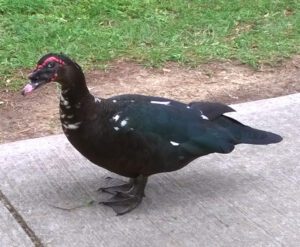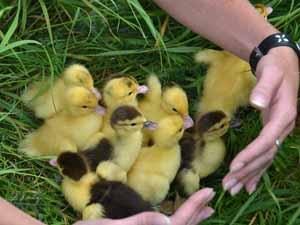The Aylesbury duck is a breed of domestic duck, originating in the United Kingdom. It was developed around the early eighteenth Century from the town of Aylesbury in Buckinghamshire, England.
Aylesbury duck is bred mainly for it’s beautiful appearance and meat. The exact origin of this breed is not clear. But in the 18th Century, raising white ducks became very popular in Aylesbury in Buckinghamshire, England.
The popularity of raising white ducks increased mainly because of high demand for white feathers as a filler for quilts. Selective breeding for size, shape and color in the nineteenth Century led to the Aylesbury duck. And during this period, duck farming became a major industry in Aylesbury.
Aylesbury is another domesticated duck breed like the Orpington duck, which is named after the place of it’s creation. The breed was originally called ‘White English‘ until 1815. Along with producing white feathers, it was also popular for it’s meat, mainly for it’s white carcass.
The Aylesbury duck was imported into the United States in 1840. But it never became popular there. But the breed was admitted into the American Poultry Association’s Standard of Perfection in 1876. And it was listed as critically endangered (as of 2013) in the United States by The Livestock Conservancy.
Aylesbury Duck Characteristics
Aylesbury duck is a large sized breed. It has pure white plumage and has white skin, while most other domestic ducks have yellow skin. Aylesbury ducks have a long body with horizontal carriage.
They have a characteristically straight, deep keel that nearly reaches the ground. Their legs and feet are orange and they have an unusually long and straight pinkish-white bill. Their legs are placed midway along the body and it stands with its underside parallel to the ground, giving it a body described as “boat-shaped”.
Their eyes are of dark grayish blue color. They have relatively long and thin swan-like neck. Aylesbury ducks are of two types; exhibition and utility. The exhibition type has a very deep keel which makes it difficult to successfully mate naturally.

While the utility type is able to mate naturally and their keel is relatively smaller. Average body weight of the Aylesbury duck is about 4.5 kg and the drakes weight about 5 kg. Photo from The Livestock Conservancy.
Uses
Aylesbury duck is mainly raised as an utility bird. They are very popular for their meat production. And the breed is also raised for ornamental and exhibition purposes.
Special Notes
Aylesbury duck is very good natured and friendly. It is a superior meat duck breed with white carcass. Young ducks will reach the slaughtering weight (about five pounds) within seven to nine weeks of age.
They can be grown fast by feeding concentrated duck feed, because they are less active and particularly not active foragers. The ducks are fair layers of moderately sized white or tinted green colored eggs. They will usually lay about 35 to 125 eggs per year.
The ducks are good mothers, and Aylesbury duckling incubates in the egg for 28 days. The Aylesbury duck is a slow moving duck breed and excellent as pets. Review full breed profile of this duck breed in the chart below.
| Breed Name | Aylesbury |
| Other Name | White English |
| Breed Purpose | Meat, Eggs, Exhibition, Ornamental, Pets |
| Special Notes | Easily Tamed, Docile, Friendly, Good as Pets |
| Breed Class | Large |
| Broodiness | Good |
| Drake | About 5 kg |
| Duck | About 4.5 kg |
| Climate Tolerance | All Climates |
| Egg Color | White or tinted green |
| Egg Size | Large |
| Egg Weight | Up to 80 grams |
| Egg Productivity | Low |
| Flying Ability | Poor |
| Rarity | Common |
| Varieties | White |
| Country of Origin | United Kingdom |





